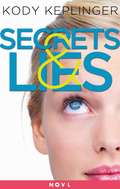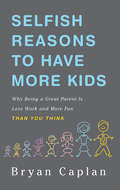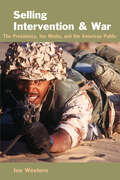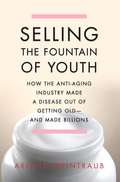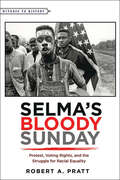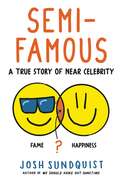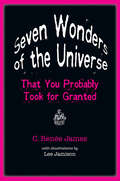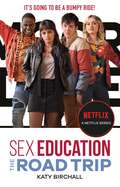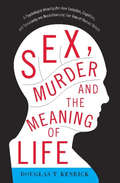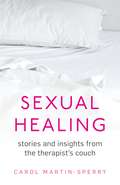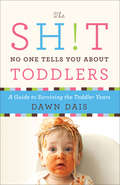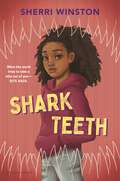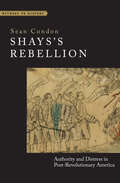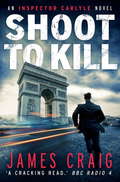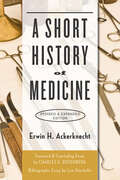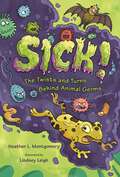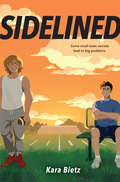- Table View
- List View
The Secret Side of Empty
by Maria E. AndreuA 2014 National Indie Excellence Award winnerA Junior Library Guild Selection, 2014A School Library Journal Top 10 Latino Books of 2014As a straight-A student with a budding romance and loyal best friend, M.T.'s life seems as apple-pie American as her blondish hair and pale skin. But M.T. hides two facts to the contrary: her full name of Monserrat Thalia and her status as an undocumented immigrant.With senior year of high school kicking into full swing, M.T. sees her hopes for a "normal” future unraveling. And it will take discovering a sense of trust in herself and others for M.T. to stake a claim in the life that she wants.Author Maria E. Andreu draws from her personal experience to tell a story that is timely, relevant, and universally poignant.
Secrets & Lies: Two Short Stories
by Kody KeplingerKody Keplinger both returns to the halls of Hamilton High and explores new territory in her collection of two e-book exclusive novellas. In these short stories, the author revisits a familiar cast of characters from THE DUFF (Designated Ugly Fat Friend) and A Midsummer's Nightmare. Explore the uniquely teen world of high school drama, secrets, and romantic entanglements from completely fresh perspectives that will intrigue fans of Kody Keplinger and new readers alike.
Selfish Reasons to Have More Kids: Why Being a Great Parent is Less Work and More Fun Than You Think
by Bryan CaplanWe've needlessly turned parenting into an unpleasant chore. Parents invest more time and money in their kids than ever, but the shocking lesson of twin and adoption research is that upbringing is much less important than genetics in the long run. These revelations have surprising implications for how we parent and how we spend time with our kids. The big lesson: Mold your kids less and enjoy your life more. Your kids will still turn out fine.Selfish Reasons to Have More Kids is a book of practical big ideas. How can parents be happier? What can they change--and what do they need to just accept? Which of their worries can parents safely forget? Above all, what is the right number of kids for you to have? You'll never see kids or parenthood the same way again.
Selling Intervention and War: The Presidency, the Media, and the American Public
by Jon WesternSelling Intervention and War examines the competition among foreign policy elites in the executive branch and Congress in winning the hearts and minds of the American public for military intervention. The book studies how the president and his supporters organize campaigns for public support for military action. According to Jon Western, the outcome depends upon information and propaganda advantages, media support or opposition, the degree of cohesion within the executive branch, and the duration of the crisis. Also important is whether the American public believes that military threat is credible and victory plausible. Not all such campaigns to win public support are successful; in some instances, foreign policy elites and the president and his advisors have to back off. Western uses several modern conflicts, including the current one in Iraq, as case studies to illustrate the methods involved in selling intervention and war to the American public: the decision not to intervene in French Indochina in 1954, the choice to go into Lebanon in 1958, and the more recent military actions in Grenada, Somalia, Bosnia, and Iraq. Selling Intervention and War is essential reading for scholars and students of U.S. foreign policy, international security, the military and foreign policy, and international conflict.
Selling Intervention and War: The Presidency, the Media, and the American Public
by Jon WesternSelling Intervention and War examines the competition among foreign policy elites in the executive branch and Congress in winning the hearts and minds of the American public for military intervention. The book studies how the president and his supporters organize campaigns for public support for military action. According to Jon Western, the outcome depends upon information and propaganda advantages, media support or opposition, the degree of cohesion within the executive branch, and the duration of the crisis. Also important is whether the American public believes that military threat is credible and victory plausible. Not all such campaigns to win public support are successful; in some instances, foreign policy elites and the president and his advisors have to back off. Western uses several modern conflicts, including the current one in Iraq, as case studies to illustrate the methods involved in selling intervention and war to the American public: the decision not to intervene in French Indochina in 1954, the choice to go into Lebanon in 1958, and the more recent military actions in Grenada, Somalia, Bosnia, and Iraq. Selling Intervention and War is essential reading for scholars and students of U.S. foreign policy, international security, the military and foreign policy, and international conflict.
Selling the Fountain of Youth: How the Anti-Aging Industry Made a Disease Out of Getting Old-And Made Billions
by Arlene WeintraubThe beauty industry—which once revolved around creams and powders, subtle agents to enhance beauty—has become the anti-aging industry, overrun with steroids, human growth hormone injections, and &“bio-identical&” hormones—all promoted as &“cures&” for getting old. Acclaimed BusinessWeek science reporter Arlene Weintraub takes us inside this world, from the marketing departments of huge pharmaceutical companies to the backroom of your local pharmacy, from celebrity enthusiasts like Suzanne Somers and Oprah to the self-medicating doctors who run chains of rejuvenation centers, all claiming that we deserve to be forever young—and promising to show us how.Weintraub reveals the shady practices that run rampant when junk science and dubious marketing meet consumer choice. She shows for the remarkable economic and cultural impact of anti-aging medicine, on the patients who partake and on the rest of us. It&’s not a pretty story, but Weintraub tells us everything we need to know to avoid being duped by this billion-dollar—and dangerous—hoax.
Selma;€™s Bloody Sunday: Protest, Voting Rights, and the Struggle for Racial Equality (Witness to History)
by Robert A. PrattOn Sunday afternoon, March 7, 1965, roughly six hundred peaceful demonstrators set out from Brown Chapel A.M.E. Church in a double-file column to march from Selma, Alabama, to the state capital of Montgomery. Leading the march were Hosea Williams of the Southern Christian Leadership Conference and John Lewis of the Student Nonviolent Coordinating Committee. Upon reaching Broad Street, the marchers turned left to cross the Edmund Pettus Bridge that spanned the Alabama River. "When we reached the crest of the bridge," recalls John Lewis, "I stopped dead still. So did Hosea. There, facing us at the bottom of the other side, stood a sea of blue-helmeted, blue-uniformed Alabama state troopers, line after line of them, dozens of battle-ready lawmen stretched from one side of U.S. Highway 80 to the other. Behind them were several dozen more armed men;¢;‚¬;€?Sheriff Clark;€™s posse;¢;‚¬;€?some on horseback, all wearing khaki clothing, many carrying clubs the size of baseball bats."The violence and horror that was about to unfold at the foot of the bridge would forever mark the day as "Bloody Sunday," one of the pivotal moments of the civil rights movement. Alabama state troopers fell on the unarmed protestors as they crossed the bridge, beating and tear gassing them. In Selma;€™s Bloody Sunday, Robert A. Pratt offers a vivid account of that infamous day and the indelible triumph of black and white protest over white resistance. He explores how the march itself;¢;‚¬;€?and the 1965 Voting Rights Act that followed;¢;‚¬;€?represented a reaffirmation of the nation;€™s centuries-old declaration of universal equality and the fulfillment of the Fifteenth Amendment to the Constitution.Selma;€™s Bloody Sunday offers a fresh interpretation of the ongoing struggle by African Americans to participate freely in America;€™s electoral democracy. Jumping forward to the present day, Pratt uses the march as a lens through which to examine disturbing recent debates concerning who should, and who should not, be allowed to vote. Drawing on archival materials, secondary sources, and eyewitness accounts of the brave men and women who marched, this gripping account offers a brief and nuanced narrative of this critical phase of the black freedom struggle.
Selma;€™s Bloody Sunday: Protest, Voting Rights, and the Struggle for Racial Equality (Witness to History)
by Robert A. PrattOn Sunday afternoon, March 7, 1965, roughly six hundred peaceful demonstrators set out from Brown Chapel A.M.E. Church in a double-file column to march from Selma, Alabama, to the state capital of Montgomery. Leading the march were Hosea Williams of the Southern Christian Leadership Conference and John Lewis of the Student Nonviolent Coordinating Committee. Upon reaching Broad Street, the marchers turned left to cross the Edmund Pettus Bridge that spanned the Alabama River. "When we reached the crest of the bridge," recalls John Lewis, "I stopped dead still. So did Hosea. There, facing us at the bottom of the other side, stood a sea of blue-helmeted, blue-uniformed Alabama state troopers, line after line of them, dozens of battle-ready lawmen stretched from one side of U.S. Highway 80 to the other. Behind them were several dozen more armed men;¢;‚¬;€?Sheriff Clark;€™s posse;¢;‚¬;€?some on horseback, all wearing khaki clothing, many carrying clubs the size of baseball bats."The violence and horror that was about to unfold at the foot of the bridge would forever mark the day as "Bloody Sunday," one of the pivotal moments of the civil rights movement. Alabama state troopers fell on the unarmed protestors as they crossed the bridge, beating and tear gassing them. In Selma;€™s Bloody Sunday, Robert A. Pratt offers a vivid account of that infamous day and the indelible triumph of black and white protest over white resistance. He explores how the march itself;¢;‚¬;€?and the 1965 Voting Rights Act that followed;¢;‚¬;€?represented a reaffirmation of the nation;€™s centuries-old declaration of universal equality and the fulfillment of the Fifteenth Amendment to the Constitution.Selma;€™s Bloody Sunday offers a fresh interpretation of the ongoing struggle by African Americans to participate freely in America;€™s electoral democracy. Jumping forward to the present day, Pratt uses the march as a lens through which to examine disturbing recent debates concerning who should, and who should not, be allowed to vote. Drawing on archival materials, secondary sources, and eyewitness accounts of the brave men and women who marched, this gripping account offers a brief and nuanced narrative of this critical phase of the black freedom struggle.
Semi-Famous: A True Story of Near Celebrity
by Josh SundquistIn this "laugh-out-loud funny&” book (Hank Green, New York Times bestselling author), social media star and comedian Josh Sundquist takes readers on his hilarious journey to the fringes of viral stardom to discover if it&’s possible to be both very famous and very happy As a semi-famous internet creator, Josh Sundquist knows what it's like to chase fame, but he also knows that more fame usually means more stress. So he set out on a pseudo-scientific investigation to find out if there is any way for fame and happiness to overlap. He attempts to define the word &“fame&”—hint: it's harder than you'd think. He turns back time to identify the first facially-recognizable celebrity (you might know his former BFF Brutus). He digs into the numbers to debunk urban legends associated with stardom (ever heard of the 27 Club?). He talks to other semi-famous people (from K-pop sensations to former child stars) and asks them: Is this fame thing making you happy? If not, why are you doing it? If so, what's your secret? All while recounting funny stories about his own cringy fame-seeking (like his many attempts, and failures, to get onto MTV). Packed with playful diagrams, fascinating insights from celebrities, and embarrassing truths from Josh&’s experience with semi-fame, this is a must-read for anyone who has ever dreamed of becoming famous…or at least going viral on TikTok.
Seven Wonders of the Universe That You Probably Took for Granted
by C. Renée JamesTime. Gravity. Night. So much of what surrounds us feels familiar and mundane. But each is a wonder that reveals profound insights into the world around us.C. Renée James's whimsical tour of seven everyday experiences—night, light, stuff, gravity, time, home, and wonder—opens the Universe to fantastical contemplation. Light? Although we need it to see, there's much more to it than meets the eye. Stuff? When it comes down to it, things are almost entirely empty space—99.9% nothing—especially when you get to the atomic level. Home? James's contemplation of our place in the Universe shows that it's not just a place to hang your hat—and that there’s really nothing else like it. James introduces each of these seven wonders with a simple question that appears to be easily answered. The questions are deceptive, though—as is James's casual, light-hearted style. Underneath lie such concepts as relativity, matter and antimatter, and the electromagnetic spectrum. Her accessible discussion uses common analogies and entertaining illustrations to provide a bundle of detail on historical discoveries and to provoke serious pondering. Fun and edifying, Seven Wonders of the Universe That You Probably Took for Granted is an inviting introduction to secret knowledge of our everyday world. This book may be 99.9% nothing, but the thoughts it will inspire are massive.
Sex Education: The Road Trip
by Katy BirchallThe only official Sex Education novel. When the screen binge is over, return to the world of Moordale with a brand-new story featuring the show's most popular characters.Maeve gets an unexpected call from her brother Sean. It's no surprise to her that he is in trouble again. But she's the only family he's got, so she must saddle up and ride to the rescue. Or at least, scrounge a lift from Aimee and drive there. . . . Otis and Eric insist they can help, and Maeve's mission becomes a summer holiday road trip. Sean's been partying with a group of decadent rich kids who have no accused him of a crime. The evidence against him is pretty damning. Trying to clear his name, Maeve and friends integrate themselves into the rich kids' circle--it's time to go undercover. Thanks to Eric's dance floor moves, Aimee's easy charm, and Otis's ability to offer good advice, they get to know the group. And they soon discover that Sean is not the only one with a motive for getting even with beautiful party girl Tabitha.This standalone YA/crossover story has everything fans love about the show: favorite characters with real emotional depth, no-holds-barred honesty about teenage relationships, brilliant humor, and a great new storyline, plus a compelling whodunit at its heart.
Sex, Murder, and the Meaning of Life: A Psychologist Investigates How Evolution, Cognition, and Complexity are Revolutionizing our View of Human Nature
by Douglas T. Kenrick&“Kenrick writes like a dream.&”—Robert Sapolsky, Professor of Biology and Neurology, Stanford University; author of A Primate&’s Memoir and Why Zebras Don&’t Get Ulcers What do sex and murder have to do with the meaning of life? Everything.In Sex, Murder, and the Meaning of Life, social psychologist Douglas Kenrick exposes the selfish animalistic underside of human nature, and shows how it is intimately connected to our greatest and most selfless achievements. Masterfully integrating cognitive science, evolutionary psychology, and complexity theory, this intriguing book paints a comprehensive picture of the principles that govern our lives. As Kenrick divulges, beneath our civilized veneer, human beings are a lot like howling hyenas and barking baboons, with heads full of homicidal tendencies and sexual fantasies. But, in his view, many ingrained, apparently irrational behaviors—such as inclinations to one-night stands, racial prejudices, and conspicuous consumption—ultimately manifest what he calls &“Deep Rationality.&”Although our heads are full of simple selfish biases that evolved to help our ancestors survive, modern human beings are anything but simple and selfish cavemen. Kenrick argues that simple and selfish mental mechanisms we inherited from our ancestors ultimately give rise to the multifaceted social lives that we humans lead today, and to the most positive features of humanity, including generosity, artistic creativity, love, and familial bonds. And out of those simple mechanisms emerge all the complexities of society, including international conflicts and global economic markets. By exploring the nuance of social psychology and the surprising results of his own research, Kenrick offers a detailed picture of what makes us caring, creative, and complex—that is, fully human. Illuminated with stories from Kenrick&’s own colorful experiences -- from his criminally inclined shantytown Irish relatives, his own multiple high school expulsions, broken marriages, and homicidal fantasies, to his eventual success as an evolutionary psychologist and loving father of two boys separated by 26 years -- this book is an exploration of our mental biases and failures, and our mind&’s great successes. Idiosyncratic, controversial, and fascinating, Sex, Murder, and the Meaning of Life uncovers the pitfalls and promise of our biological inheritance.
Sex, Murder, and the Meaning of Life: A Psychologist Investigates How Evolution, Cognition, and Complexity are Revolutionizing our View of Human Nature
by Douglas T Kenrick"Kenrick writes like a dream." -- Robert Sapolsky, Professor of Biology and Neurology, Stanford University; author of A Primate's Memoir and Why Zebras Don't Get Ulcers What do sex and murder have to do with the meaning of life? Everything. In Sex, Murder, and the Meaning of Life, social psychologist Douglas Kenrick exposes the selfish animalistic underside of human nature, and shows how it is intimately connected to our greatest and most selfless achievements. Masterfully integrating cognitive science, evolutionary psychology, and complexity theory, this intriguing book paints a comprehensive picture of the principles that govern our lives. As Kenrick divulges, beneath our civilized veneer, human beings are a lot like howling hyenas and barking baboons, with heads full of homicidal tendencies and sexual fantasies. But, in his view, many ingrained, apparently irrational behaviors -- such as inclinations to one-night stands, racial prejudices, and conspicuous consumption -- ultimately manifest what he calls "Deep Rationality.&" Although our heads are full of simple selfish biases that evolved to help our ancestors survive, modern human beings are anything but simple and selfish cavemen. Kenrick argues that simple and selfish mental mechanisms we inherited from our ancestors ultimately give rise to the multifaceted social lives that we humans lead today, and to the most positive features of humanity, including generosity, artistic creativity, love, and familial bonds. And out of those simple mechanisms emerge all the complexities of society, including international conflicts and global economic markets. By exploring the nuance of social psychology and the surprising results of his own research, Kenrick offers a detailed picture of what makes us caring, creative, and complex -- that is, fully human. Illuminated with stories from Kenrick's own colorful experiences -- from his criminally inclined shantytown Irish relatives, his own multiple high school expulsions, broken marriages, and homicidal fantasies, to his eventual success as an evolutionary psychologist and loving father of two boys separated by 26 years -- this book is an exploration of our mental biases and failures, and our mind's great successes. Idiosyncratic, controversial, and fascinating, Sex, Murder, and the Meaning of Life uncovers the pitfalls and promise of our biological inheritance.
Sexual Healing: Stories and insights from the therapist`s couch
by Carol Martin-SperryThrough tales of adultery and addiction, desire and its loss, good sex, bad sex and no sex, sexual power struggles, and childhood abuse this book covers the big questions about sex:· What is the nature of passion and desire· How can we remain faithful in a long-term relationship· What happens to sex when you have a baby· How anxiety and shame are the enemies of pleasure· How anger, blame and guilt put us off sex· How childhood messages turn us towards diverse behaviours and fantasies· How changing gender roles are playing out in the bedroom· How our sexuality develops throughout our lives· How to address sexual difficulties and find healing with sex therapy exercisesWhether we are sexually active or not, our sexuality is a vital part of our being. The variety and complexity of sex and sexuality are richly illustrated in these unique and compelling stories. Illuminated by psychological insights, they can bring informed awareness and healing to the reader.
Sexuality and Our Diversity: Integrating Culture with the Biopsychosocial Version 1.0
by Marcus TyeSexuality and Our Diversity: Integrating Culture with the Biopsychosocial by Marcus Tye explores, with an integrated approach, the complex dimensions of biology, culture, psychology, sociology, history, and philosophy that explain human sexual diversity. While this text is primarily focused on the present, it also explores selected aspects of history to lend perspective to students that contemporary controversies have deep historical roots.
The Sh!t No One Tells You About Toddlers (Sh!t No One Tells You #2)
by Dawn DaisThey’re getting bigger. And you’re not getting any more sleep.Second in the Sh!t No One Tells You series, in The Sh!t No One Tells You About Toddlers Dawn Dais tells it like it is - again - offering real advice for parents of growing children. Filled with tips, encouragement, and a strong dose of humor, The Sh!t No One Tells You About Toddlers is a survival handbook for parents on the edge.Chapters include:You Suck at This. It’s not just your imagination.Walking Is Hard. Bruising is considerably less difficult.Remember When You Judged Other Parents? Prepare to eat your words, with a side of karma’s a bitch.Restaurants Are Battle Zones. Spoiler Alert: You are not the victor.Kids Get Sick. Then everyone gets sick.This Childhood Will Be Televised. Hello, camera phones.Your TV Has Been Hijacked. By things with very high-pitched voices.Coming from one empathetic parent to another, the tips in this book are real, clever, honest, and designed to make life with a terrible two- or three-year-old a little bit more manageable. Hilarious, helpful, and handy, this book will be appreciated by any parent who has asked: "Why didn’t anybody warn me that unconditional love would be so much work?”
Shark Teeth
by Sherri WinstonFrom National Book Award longlisted author Sherri Winston comes an important middle grade novel about a girl's tumultuous journey to keep her family together, even when she's falling apart.Sharkita “Kita” Hayes is always waiting.Waiting for her mama to mess up.Waiting for social services to be called again.Waiting for her and her siblings to be separated.Waiting for her worst fear to come true.But Mama promises things are different now. She's got a good job, she's stopped drinking, stopped going out every night-it's almost enough to make Kita believe her this time. But even as Kita's life is going good, she can't shake the feeling that everything could go up in flames at any moment. When her assistant principal and trusted dance coach starts asking questions about her home life, Kita is more determined than ever to keep up appearances and make sure her family stays together-even if it means falling apart herself. As the threat of her family being separated again circles like a shark in the water, the pressure starts to get to Kita. But could it be that Kita's worst fear is actually the best thing that could happen to her family . . . and to her?
Shays's Rebellion: Authority and Distress in Post-Revolutionary America (Witness to History)
by Sean CondonThroughout the late summer and fall of 1786, farmers in central and western Massachusetts organized themselves into armed groups to protest against established authority and aggressive creditors. Calling themselves "regulators" or the "voice of the people," these crowds attempted to pressure the state government to lower taxes and provide relief to debtors by using some of the same methods employed against British authority a decade earlier. From the perspective of men of wealth and station, these farmers threatened the foundations of society: property rights and their protection in courts and legislature.In this concise and compelling account of the uprising that came to be known as Shays’s Rebellion, Sean Condon describes the economic difficulties facing both private citizens and public officials in newly independent Massachusetts. He explains the state government policy that precipitated the farmers’ revolt, details the machinery of tax and debt collection in the 1780s, and provides readers with a vivid example of how the establishment of a republican form of government shifted the boundaries of dissent and organized protest. Underscoring both the fragility and the resilience of government authority in the nascent republic, the uprising and its aftermath had repercussions far beyond western Massachusetts; ultimately, it shaped the framing and ratification of the U.S. Constitution, which in turn ushered in a new, stronger, and property-friendly federal government. A masterful telling of a complicated story, Shays’s Rebellion is aimed at scholars and students of American history.
Shays's Rebellion: Authority and Distress in Post-Revolutionary America (Witness to History)
by Sean CondonThroughout the late summer and fall of 1786, farmers in central and western Massachusetts organized themselves into armed groups to protest against established authority and aggressive creditors. Calling themselves "regulators" or the "voice of the people," these crowds attempted to pressure the state government to lower taxes and provide relief to debtors by using some of the same methods employed against British authority a decade earlier. From the perspective of men of wealth and station, these farmers threatened the foundations of society: property rights and their protection in courts and legislature.In this concise and compelling account of the uprising that came to be known as Shays’s Rebellion, Sean Condon describes the economic difficulties facing both private citizens and public officials in newly independent Massachusetts. He explains the state government policy that precipitated the farmers’ revolt, details the machinery of tax and debt collection in the 1780s, and provides readers with a vivid example of how the establishment of a republican form of government shifted the boundaries of dissent and organized protest. Underscoring both the fragility and the resilience of government authority in the nascent republic, the uprising and its aftermath had repercussions far beyond western Massachusetts; ultimately, it shaped the framing and ratification of the U.S. Constitution, which in turn ushered in a new, stronger, and property-friendly federal government. A masterful telling of a complicated story, Shays’s Rebellion is aimed at scholars and students of American history.
Shoot to Kill (Inspector Carlyle #7)
by James CraigWhen French gangster Tuco Martinez threatens Carlyle and his family, the inspector has to call on the resources and skills of Dominic Silver to try and see him off. But Dom won’t do all the dirty work and so Carlyle has to go into hiding. Cut off from his home turf, both literally and metaphorically, Carlyle struggles to cope with the situation while meanwhile, back in London, the charismatic major, Christian Holroyd, is finally spiralling completely out of control…
A Short History of Medicine
by Erwin H. Ackerknecht Lisa Haushofer.Erwin H. Ackerknecht;€™s A Short History of Medicine is a concise narrative, long appreciated by students in the history of medicine, medical students, historians, and medical professionals as well as all those seeking to understand the history of medicine.Covering the broad sweep of discoveries from parasitic worms to bacilli and x-rays, and highlighting physicians and scientists from Hippocrates and Galen to Pasteur, Koch, and Roentgen, Ackerknecht narrates Western and Eastern civilization;€™s work at identifying and curing disease. He follows these discoveries from the library to the bedside, hospital, and laboratory, illuminating how basic biological sciences interacted with clinical practice over time. But his story is more than one of laudable scientific and therapeutic achievement. Ackerknecht also points toward the social, ecological, economic, and political conditions that shape the incidence of disease. Improvements in health, Ackerknecht argues, depend on more than laboratory knowledge: they also require that we improve the lives of ordinary men and women by altering social conditions such as poverty and hunger.This revised and expanded edition includes a new foreword and concluding biographical essay by Charles E. Rosenberg, Ackerknecht;€™s former student and a distinguished historian of medicine. A new bibliographic essay by Lisa Haushofer explores recent scholarship in the history of medicine.
A Short History of Medicine
by Erwin H. Ackerknecht Lisa Haushofer.Erwin H. Ackerknecht;€™s A Short History of Medicine is a concise narrative, long appreciated by students in the history of medicine, medical students, historians, and medical professionals as well as all those seeking to understand the history of medicine.Covering the broad sweep of discoveries from parasitic worms to bacilli and x-rays, and highlighting physicians and scientists from Hippocrates and Galen to Pasteur, Koch, and Roentgen, Ackerknecht narrates Western and Eastern civilization;€™s work at identifying and curing disease. He follows these discoveries from the library to the bedside, hospital, and laboratory, illuminating how basic biological sciences interacted with clinical practice over time. But his story is more than one of laudable scientific and therapeutic achievement. Ackerknecht also points toward the social, ecological, economic, and political conditions that shape the incidence of disease. Improvements in health, Ackerknecht argues, depend on more than laboratory knowledge: they also require that we improve the lives of ordinary men and women by altering social conditions such as poverty and hunger.This revised and expanded edition includes a new foreword and concluding biographical essay by Charles E. Rosenberg, Ackerknecht;€™s former student and a distinguished historian of medicine. A new bibliographic essay by Lisa Haushofer explores recent scholarship in the history of medicine.
Sick!: The Twists and Turns Behind Animal Germs
by Heather L. MontgomeryWhen a super sickness lands on the land, when a parasite becomes more than a pest, when an infection ignites an epidemic, what's a body to do? Your body is an animal body, so why not ask the animals?Follow the scientists, around the world and into their labs, who are studying animals and the germs that attack them. From fungus-ridden frogs with fevers to bacteria-resistant buzzards and everything in-between, animals have A LOT to teach us about infections. But-reader beware!!-the story of germs is filled with twists and turns.In this fascinating, highly visual nonfiction book packed with colorful, comic-style art, you'll discover not only the cool ways that animal bodies (and our bodies) fight back against pesky pathogens, but also the amazing and surprising ways we can learn to work together with germs.Sick! The Twists and Turns Behind Animal Germs is written by Heather L. Montgomery with graphic novel-style art from Lindsey Leigh.
Sick!: The Twists and Turns Behind Animal Germs
by Heather L. MontgomeryWhen a super sickness lands on the land, when a parasite becomes more than a pest, when an infection ignites an epidemic, what's a body to do? Your body is an animal body, so why not ask the animals?Follow the scientists, around the world and into their labs, who are studying animals and the germs that attack them. From fungus-ridden frogs with fevers to bacteria-resistant buzzards and everything in-between, animals have A LOT to teach us about infections. But-reader beware!!-the story of germs is filled with twists and turns.In this fascinating, highly visual nonfiction book packed with colorful, comic-style art, you'll discover not only the cool ways that animal bodies (and our bodies) fight back against pesky pathogens, but also the amazing and surprising ways we can learn to work together with germs.Sick! The Twists and Turns Behind Animal Germs is written by Heather L. Montgomery with graphic novel-style art from Lindsey Leigh.
Sidelined
by Kara BietzAn emotional YA romance about small town secrets, high school football, and broken hearts.Julian Jackson has a short to-do list for his senior year at Crenshaw County High School in Meridien, Texas: football, football, and more football. He knows he's only got one chance to earn a college scholarship and make it out of his small town, and keeping his head down, his grades up, and his cleats on the field is that one chance. And then Elijah Vance walks back into his life, throwing all of his carefully-laid plans into a tailspin.Elijah and Julian used to be best friends, maybe even on their way to something more than just friends. But three years ago, Elijah broke into the school to steal money from the coach's office, and Julian was the one who turned him in. After that, Elijah and his family disappeared without a trace. And now he's back, sitting at Julian's grandmother's kitchen table. But time and distance haven't erased all of their feelings, and Elijah knows that he finally has a chance to prove to Julian that he's not the same person he was three years ago. But with secrets still growing between them and an uncertain future barreling towards them, it may be harder to lean on each other than they thought.

